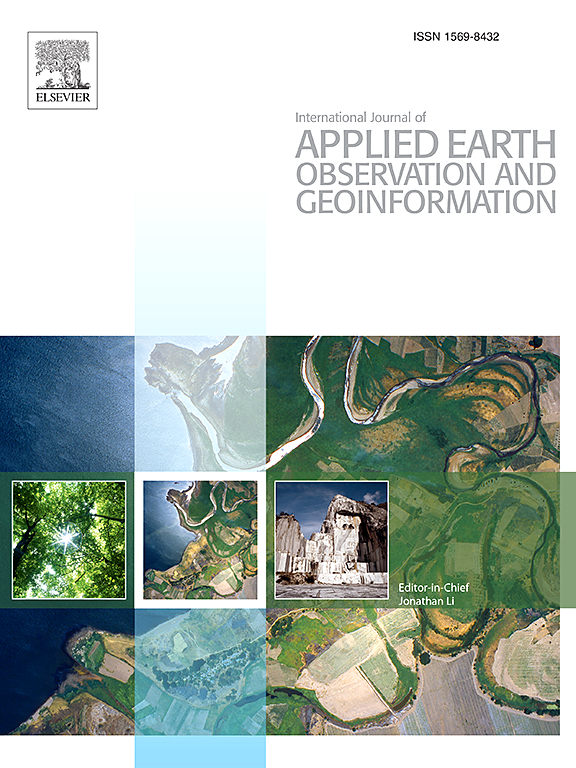Automated vicarious radiometric validation of spaceborne thermal infrared sensors at non-dedicated validation sites using deep learning-based cloud filtering
IF 8.6
Q1 REMOTE SENSING
International journal of applied earth observation and geoinformation : ITC journal
Pub Date : 2025-05-30
DOI:10.1016/j.jag.2025.104617
引用次数: 0
Abstract
Vicarious calibration/validation (Cal/Val) is essential for ensuring the radiometric accuracy of spaceborne thermal infrared (TIR) sensors. Anticipating an increase in the number of TIR sensors in the near future, this study developed an automated vicarious radiometric validation method based on in situ water temperature measurements from 14 sites in lakes and bays across Japan, which are not specifically dedicated to Cal/Val of satellite sensors. In addition, we applied a contextual image classification model based on the Swin Transformer architecture to create a fully automated filtering procedure to remove cloudy data. The proposed methods were developed and evaluated using the data acquired by well-calibrated satellite sensors, namely Advanced Spaceborne Thermal Emission and Reflection Radiometer Thermal Infrared Radiometer (ASTER TIR), Landsat 8 Thermal Infrared Sensor (TIRS), and Landsat 9 TIRS-2, as reference targets. To develop a contextual image classification model, we fine-tuned a pre-trained Swin Transformer model with our own training data comprising 921,967 chip images created from ASTER TIR band 13 and Landsat 8 TIRS band 10 images selected from global regions. The developed image classification model achieved an overall accuracy of 96.20 %. However, when applied only to the study areas, the accuracy decreased to 94.85 %, because all the target sites were exclusively located in lakes and bays. The classification model was localized to our study areas by adjusting the probability threshold. Combining contextual image classification with quantitative thresholds, the model successfully classified 90 % of the cloud-free daytime ASTER data and Landsat 8 data. The accuracy for cloud-free classification was 81 % and 86 % for nighttime ASTER data and Landsat 9 data, respectively. Consequently, 169, 58, 500, and 130 matchups were automatically identified for daytime ASTER, nighttime ASTER, Landsat 8, and Landsat 9, respectively. The in situ water temperature for each matchup was converted to top-of-atmosphere brightness temperature (TOA BT) through radiative transfer calculations. In situ-based and satellite-based TOA BT agreed very well within the residual bias error of less than ±0.4 K except for nighttime ASTER data that seemed to be affected by insufficient skin temperature correction. The correlation between in situ-based and satellite-based TOA BT was strong, with R2 values ranging from 0.97 to 0.99, for daytime and nighttime ASTER, Landsat 8, and Landsat 9. The statistically estimated offsets between the in situ-based and satellite-based TOA BT were nearly equivalent to previously reported Cal/Val result and within the acceptable range of the sensors’ requirements, indicating that our method and data are suitable for the radiometric validation of spaceborne TIR sensors.
利用基于深度学习的云滤波,在非专用验证站点对星载热红外传感器进行自动替代辐射验证
替代校准/验证(Cal/Val)是保证星载热红外(TIR)传感器辐射测量精度的关键。预计TIR传感器的数量在不久的将来会增加,本研究开发了一种自动化替代辐射验证方法,该方法基于日本各地湖泊和海湾的14个地点的原位水温测量,而不是专门用于卫星传感器的Cal/Val。此外,我们应用了基于Swin Transformer架构的上下文图像分类模型,创建了一个完全自动化的过滤过程来去除云雾数据。该方法是利用先进星载热发射和反射辐射计热红外辐射计(ASTER TIR)、Landsat 8热红外传感器(TIRS)和Landsat 9 TIRS-2卫星传感器作为参考目标获得的数据进行开发和评估的。为了开发上下文图像分类模型,我们使用我们自己的训练数据对预训练的Swin Transformer模型进行了微调,这些数据包括从全球各地选择的ASTER TIR波段13和Landsat 8 TIRS波段10图像创建的921,967张芯片图像。所建立的图像分类模型总体准确率达到96.20%。然而,当只应用于研究区域时,由于所有目标地点都位于湖泊和海湾,准确率下降到94.85%。通过调整概率阈值,将分类模型定位到我们的研究区域。结合上下文图像分类和定量阈值,该模型成功地对90%的无云白天ASTER数据和Landsat 8数据进行了分类。夜间ASTER数据和Landsat 9数据的无云分类准确率分别为81%和86%。因此,白天ASTER、夜间ASTER、Landsat 8和Landsat 9分别自动识别了169、58、500和130个配对。通过辐射传输计算,将每次匹配的原位水温转换为大气顶亮度温度(TOA BT)。除了夜间ASTER数据似乎受到皮肤温度校正不足的影响外,基于态势和基于卫星的TOA的BT在小于±0.4 K的残余偏差误差范围内非常一致。在白天和夜间ASTER、Landsat 8和Landsat 9上,基于地形和卫星的TOA BT相关性较强,R2值在0.97 ~ 0.99之间。态势与星载TOA BT之间的统计估计偏移量与之前报道的Cal/Val结果几乎相等,并且在传感器要求的可接受范围内,表明我们的方法和数据适用于星载TIR传感器的辐射验证。
本文章由计算机程序翻译,如有差异,请以英文原文为准。
求助全文
约1分钟内获得全文
求助全文
来源期刊

International journal of applied earth observation and geoinformation : ITC journal
Global and Planetary Change, Management, Monitoring, Policy and Law, Earth-Surface Processes, Computers in Earth Sciences
CiteScore
12.00
自引率
0.00%
发文量
0
审稿时长
77 days
期刊介绍:
The International Journal of Applied Earth Observation and Geoinformation publishes original papers that utilize earth observation data for natural resource and environmental inventory and management. These data primarily originate from remote sensing platforms, including satellites and aircraft, supplemented by surface and subsurface measurements. Addressing natural resources such as forests, agricultural land, soils, and water, as well as environmental concerns like biodiversity, land degradation, and hazards, the journal explores conceptual and data-driven approaches. It covers geoinformation themes like capturing, databasing, visualization, interpretation, data quality, and spatial uncertainty.
 求助内容:
求助内容: 应助结果提醒方式:
应助结果提醒方式:


